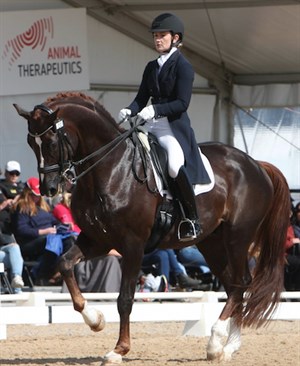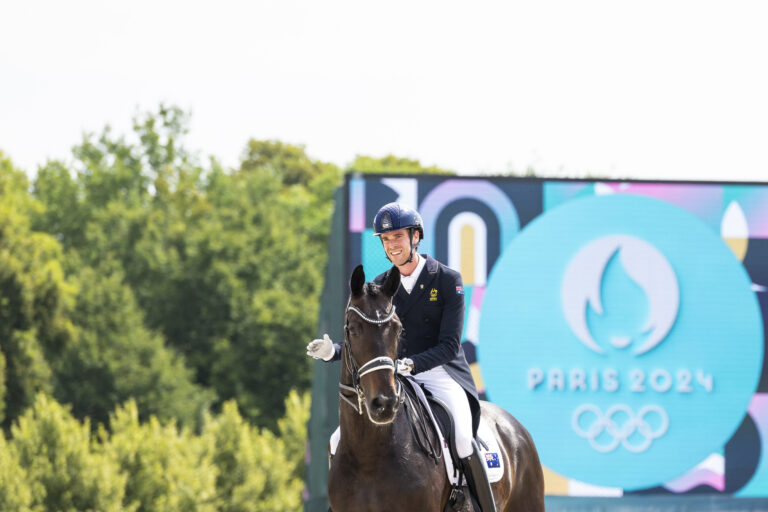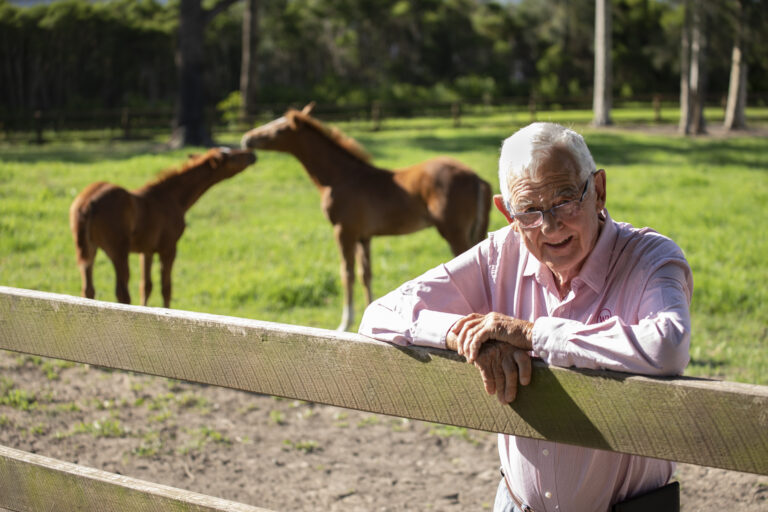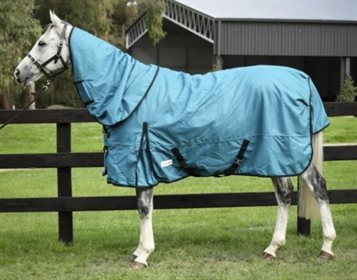Alexis Hellyer with Bluefields Floreno.
© Roger Fitzhardinge
By Roger Fitzhardinge
The dressage for the World Equestrian Games (WEG) has three components. The first is the Grand Prix test (Team Competition) in which all competitors from all countries compete. This is divided into four sections of horse and rider combinations. The draw is by country, with each having four combinations and so there are four “go-arounds” or rotations. The countries decide which riders will ride in the first, second, third and final rotation. Usually the last rotation to go holds the highest ranking and best performances for their country. The competition will start on Tuesday (today!) at 10:30pm Australian Eastern Standard Time (AEST), with the trot up (or as the Americans call it… the jog!!!) This is where every horse is walked and trotted before the judges (the Ground Jury) and the FEI vet, to check that it is sound of limb and healthy to compete. Such things as spur marks will also be observed and noted.

Kristy Oatley and Du Soleil.
© Eric Knoll
The Grand Prix test is completed by all combinations in the first go around. It is well worth looking at this test so you get a feeling for where marks are allocated. It is seen that there are a lot of marks for piaffe and passage and the transitions in and out. The horses that find these two movements difficult will find it very nearly impossible to pick up marks to counteract the lack of enthusiasm for piaffe and passage. It also can be seen that there is a lot of marks for the canter work, when everyone thinks the trot is the most important but in the Grand Prix test it is far from the most important. Above all, the most important single factor in getting a good mark in this test is to make a mistake free test — meaning no mistakes in the flying changes, no interruptions in the trot rhythm, and most importantly good canter pirouettes, as they have a double mark or coefficient.
View the Grand Prix test here.
At the completion of all the Grand Prix tests, the team scores will be collated and a medal ceremony will follow. The top 30 horses will then go into the Grand Prix Special competition. There is now a medal ceremony for the placegetters in this class; this didn’t used to be the case. This test is really to find the top 15 for the final test — the Freestyle.

Brett Parbery and DP Weltmieser.
© Roger Fitzhardinge
The Grand Prix Special test is well worth looking at; it is long and complicated, with many passage to extended transitions, two lots of one tempi changes, and one lot of nine one tempis on the centreline between the pirouettes. It is obvious when reading or seeing these tests how fit these horses need to be to be able to maintain the strength and enthusiasm from the beginning to the end of these testing routines. Australia’s two home-based horses will also have to contend with the extreme humidity being experienced in Tryon at the moment. Brett Parbery with DP Weltmieser, and Alexis Hellyer with Bluefields Floreno will no doubt be very aware of all those stress factors that will need to be kept under control to keep their horses happy. For sure these riders are already experienced with extreme weather, humidity and the stress it creates, and that will hold them in good stead. The European and American based horses will surely have a slight advantage having being already acclimatised to the hot summer conditions they have just been through.
View the Grand Prix Special test here.
At the completion of the Grand Prix Special, the top 15 horses will go into the Kur, or Grand Prix Freestyle as we know it. If in that top 15 horses in the Special there are four from one country, then that country may only take three forward to the Kur. The winner of the Grand Prix Freestyle is the individual gold medallist irrespective of the previous two tests, so the 15th ranked horse from the Special could win a gold medal in the Freestyle.
The new format for the degree of difficulty mark will be the first time used at a World Equestrian Games. This mark is predetermined from the riders’ routines being assessed on each individual movement and the degree of difficulty it allows. The riders must now follow their pattern that the judges will already be aware of prior to the test, with a small amount of flexibility allowed. This degree of difficulty mark will surely see the top riders pushing the boundaries to get that extra mark for making a test more difficult. The risk being that if you make a mistake by making the test movements too complicated and as a consequence making mistakes, then negative marks happen. So the riders must be aware of that; despite the degree of difficulty, the fluency, harmony and ease of each movement must predominate.

Mary Hanna and Boogie Woogie 6.
© Eric Knoll
The three top placed riders in this test, irrespective of how they went in the Grand Prix and the Special, will be the WEG gold, silver and bronze medallists.
Now it’s up to everyone producing sound healthy horses for the JOG!! And then countries will need to nominate their rider order, and the draw will be published. It’s time!!!!
READ THE LATEST NEWS ARTICLES HERE







